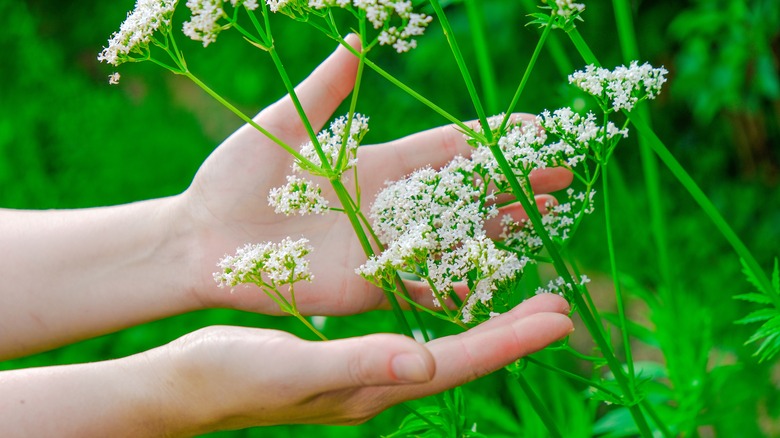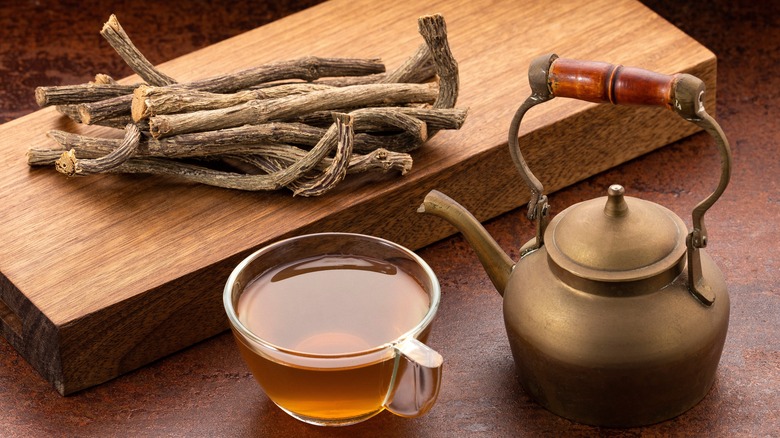Growing This Beautiful Flower Might Be Able To Improve Your Sleep
Before modern medicine, humans often turned to nature to cure their ills, and fossil evidence suggests that we've been using plants as medicine for at least 60,000 years. This practice, called herbalism, still exists today, and much of it is supported by science. Today, many herbalists still prefer these more natural solutions due to the number of side effects of certain medications. For example, sleeping pills used for insomnia can cause prolonged drowsiness, memory impairments, and dependency.
The beautiful flowering plant valerian has been documented for its ability to improve sleep with minimal to no side effects. The use of valerian was first recorded in ancient Greece. Today, it's a common ingredient in teas meant to make you sleepy, as valerian offers an all-natural alternative to habit-forming sleeping pills. Valerian's medicinal properties are found within its roots and rhizomes or underground stems, and there are many ways to take or ingest it. While you can buy it in several forms, you can grow it yourself and make a homemade herbal tea. Valerian can be grown easily outdoors in full sun. It is a good candidate for a container, as it is an invasive species and will spread if allowed.
How to grow valerian for medicinal use
Growing valerian yourself allows you to always have it on hand for a fraction of the cost. If you like the idea of cultivating certain plants for their medicinal properties, you're likely to find several varieties that you can easily grow in your region. Valerian, specifically, is hardy throughout North America from zones 4 to 8. They're best started indoors six to eight weeks before the last frost. Confirm the date of your last frost with local weather resources or the Farmer's Almanac. For the best chance of success, plant valerian seeds in a seed starter potting mix.
After the danger of frost has passed, you can transfer seedlings outside. Plant valerian in a garden bed where you could use some ground cover, like in an area in need of weed suppression. Choose a spot that receives at least six hours of direct sunlight daily. Valerian prefers loamy soil and is tolerant of a variety of pH balances. It can grow as a companion plant alongside other species that may need soil with an alkaline or even acidic pH. However, growing valerian in a container removes the risk of this plant becoming too weedy and invasive.
Creating a relaxing hot brew from valerian roots
Though prolonged use of valerian is also not recommended, it can be used for up to three months without the risk of dependency. Nevertheless, it is better suited for situational bouts of insomnia, and you should consult a doctor before taking valerian for over one month. Once you've grown valerian, you can make your own tea, but you'll need empty tea bags or a reusable tea steeper. Though you can make a simple tea with valerian only, you should consider adding more elements for flavor. Fruit pieces, cinnamon, mint, and echinacea are some popular choices.
To prepare for the brew, cleanse and dry the plant. Then, separate the plant, cut off the roots, and let the roots dry. While the leaves are edible, the roots hold the medicinal properties. Cut up or grind the roots so they're small enough to fit into the bag or steeper, and add any additional herbs. Using 2 tablespoons of a valerian root blend will yield one cup of tea. Pour a cup of boiling water over the bag or steeper and allow the root tea to steep for up to ten minutes. You could feel positive effects right away, or you may find you need to drink the tea for a few days for it to take effect.


